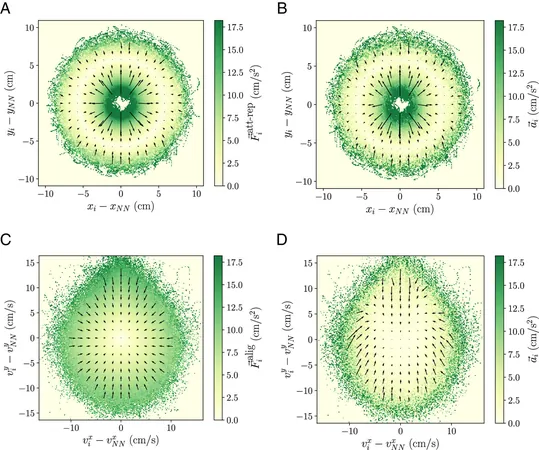
The Secret to Collective Animal Movements: Why Speed is the Key in Fish Schools
2024-11-18
Author: Arjun
Introduction
Few natural phenomena are as captivating as witnessing a flock of starlings in a breathtaking aerial display over the West Pier in Brighton or a school of fish darting gracefully to evade a predator. These mesmerizing collective movements are not just beautiful; they showcase an intricate social network at play among grouping animals, whether they are birds or fish.
Research Insights
Scientists from the Science of Intelligence in Berlin and the Universitat Politècnica de Catalunya in Barcelona have recently unveiled fascinating insights into how these animals maintain cohesion and make swift decisions during movement. Their research reveals that the interactions among these animals are driven by a delicate balance of attraction, repulsion, and alignment—factors that come together to create the stunning choreography we so admire.
The Force Map
The study, published in the Proceedings of the National Academy of Sciences (PNAS), highlights a novel concept termed the "force map." This visual tool illustrates the relative speeds of individuals within a group through arrows of varying lengths, indicating the direction and momentum of each member. Initially tested on simulated flocks, the scientists later applied these findings to real fish schools, uncovering unexpected behavioral patterns that challenged existing models of collective movement.
Dynamic Leader-Follower Roles
"By analyzing experimental data from fish schools alongside computer model simulations, we discovered that social interactions among fish are significantly influenced by their relative speeds," explains Pawel Romanczuk, a senior author of the study. "Fast-moving fish tend to attract followers, as individuals align themselves with quicker neighbors while ignoring the slower ones."
This dynamic leads to constant fluctuations in leader-follower roles, dictated by the speed of each individual. Essentially, the fish that swim faster become the de facto leaders, guiding the group toward safety from predators or toward food sources. This behavioral adaptation is vital for survival, as it allows the group to react swiftly to changes in the environment.
Perception and Information
Interestingly, faster-moving fish are perceived by their peers as having more crucial information, making their movements more influential. When one fish speeds up, others might think, "There must be something important going on; I need to follow!" This instinctual behavior not only ensures safety but harnesses the accumulated knowledge of the group.
Biological Adaptations
Moreover, fish are equipped with unique biological adaptations that aid in this communication. Besides visual cues, they utilize the lateral line—a sophisticated system of sensory organs that detects vibrations and pressure changes in the water. This allows them to sense their neighbors’ speeds, making it easier for followers to tag along with the leading fish during crucial moments.
Broader Implications
The implications of this study extend beyond fish schools, offering a fresh perspective on collective behavior in various animal species, including birds and even terrestrial animals. Understanding the intricacies of leader-follower dynamics powered by speed could unlock new avenues for research in ecology and behavioral science.
Conclusion
In summary, speed plays a vital role in the collective movements of animals, shaping social structures and survival strategies. This groundbreaking research sheds light on the hidden complexities of these interactions and underscores the importance of speed as a factor in maintaining group coherence. Next time you witness a mesmerizing display of nature, remember that behind the beauty lies a sophisticated dance driven by speed and social communication—an extraordinary testament to the wonders of the animal kingdom.



 Brasil (PT)
Brasil (PT)
 Canada (EN)
Canada (EN)
 Chile (ES)
Chile (ES)
 España (ES)
España (ES)
 France (FR)
France (FR)
 Hong Kong (EN)
Hong Kong (EN)
 Italia (IT)
Italia (IT)
 日本 (JA)
日本 (JA)
 Magyarország (HU)
Magyarország (HU)
 Norge (NO)
Norge (NO)
 Polska (PL)
Polska (PL)
 Schweiz (DE)
Schweiz (DE)
 Singapore (EN)
Singapore (EN)
 Sverige (SV)
Sverige (SV)
 Suomi (FI)
Suomi (FI)
 Türkiye (TR)
Türkiye (TR)